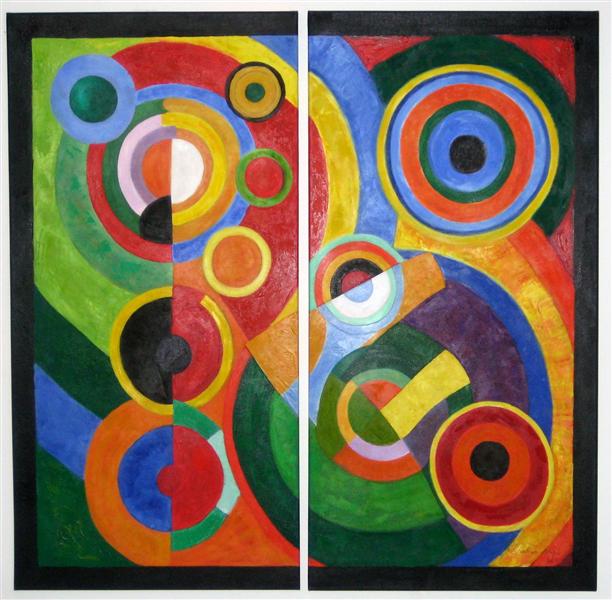
Orphism (Simultanism)
Art movement
Orphism or Orphic Cubism, a term coined by the French poet Guillaume Apollinaire in 1912, was an offshoot of Cubism that focused on pure abstraction and bright colors, influenced by Fauvism, the theoretical writings of Paul Signac, Charles Henry and the dye chemist Eugène Chevreul. This movement, perceived as key in the transition from Cubism to Abstract art, was pioneered by František Kupka, Robert Delaunay and Sonia Delaunay, who relaunched the use of color during the monochromatic phase of Cubism. The meaning of the term Orphism was elusive when it first appeared and remains to some extent vague.
The Orphists were rooted in Cubism but moved toward a pure lyrical abstraction, seeing painting as the bringing together of a sensation of pure colors. More concerned with the expression and significance of sensation, this movement began with recognizable subjects but was rapidly absorbed by increasingly abstract structures. Orphism aimed to dispense with recognizable subject matter and to rely on form and color to communicate meaning. The movement also aimed to express the ideals of Simultanism: the existence of an infinitude of interrelated states of being.
The decomposition of spectral light expressed in Neo-Impressionist color theory of Paul Signac and Charles Henry played an important role in the formulation of Orphism. Robert Delaunay, Albert Gleizes, and Gino Severini, all knew Henry personally. Charles Henry, a mathematician, inventor, esthetician, and intimate friend of the Symbolist writers Félix Fénéon and Gustave Kahn, met Seurat, Signac and Pissarro during the last Impressionist exhibition in 1886. Henry would take the final step in bringing emotional associational theory into the world of artistic sensation: something that would influence greatly the Neo-Impressionists. Henry and Seurat were in agreement that the basic elements of art—the line, particle of color, like words—could be treated autonomously, each possessing an abstract value independent of one another, if so chose the artist. "Seurat knows well" wrote Fénéton in 1889, "that the line, independent of its topographical role, possesses an assessable abstract value" in addition, of course, to the particles of color, and the relation of both to the observer's emotion. The underlying theory behind Neo-Impressionsim would have a lasting effect on the works produced in the coming years by the likes of Robert Delaunay. Indeed, the Neo-Impressionists had succeeded in establishing an objective scientific basis for their painting in the domain of color. The Cubists were to do so in both the domain of form and dynamics, and the Orphists would do so with color too.
The Symbolists had used the word orphique in relation to the Greek myth of Orpheus, who they perceived as the ideal artist. Apollinaire had written a collection of quatrains in 1907 entitled Bestiaire ou cortège d’Orphée (Paris, 1911), within which Orpheus was symbolized as a poet and artist. For both Apollinaire and the Symbolists who preceded him, Orpheus was associated with mysticism, something that would inspire artistic endeavors. The voice of light that Apollinaire mentioned in his poems was a metaphor for inner experiences. Though not fully articulated in his poems, the voice of light is identified as a line that could be colored and become a painting. The Orphic metaphor thus represented the artist’s power to create new structures and color harmonies, in an innovative creative process that combined to form a sensuous experience.
This is a part of the Wikipedia article used under the Creative Commons Attribution-Sharealike 3.0 Unported License (CC-BY-SA). The full text of the article is here →
Wikipedia: https://en.wikipedia.org/wiki/Orphism_(art)